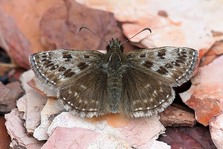

Biodiversity
Action
Plan
Open Mosaic Habitat on previously developed land is found where there are modified soils and successional communities have become established in a mosaic with bare substrate.
Previously developed land often has thin soils, deficient in nutrients; sometimes alien soils and other materials such as mine spoil, rubble and railway ballast, have been introduced.
Colonising vegetation is often sparse and rapid succession to scrub and woodland is slow. Plant communities tolerant of poor and disturbed soil become established in a patchwork with bare soil or substrate.
Species supported by previously developed land.
Plants
Sites may support rare plants or special plant communities including, mosses, liverworts, lichens and orchids.
Invertebrates
Large numbers of invertebrates, especially species such as bees, wasps, flies and beetles that are declining elsewhere.
Butterflies: Dingy skipper, Small Blue, Small Heath, Wall
Reptiles: Common lizard
Amphibians: Great crested newt and other amphibians if ponds present or nearby and damper areas on site.
Mammals: Voles, shews, mice, bats, Hedgehog
Birds: Grey Partridge, Little Ringed Plover

Amphibians, reptiles, mammals and birds may also use these sites, attracted by the supply of invertebrates and seeds, and the range of features for foraging and shelter. Some require damp areas and some dry sunny areas.
A number of previously developed sites have been reclaimed, restored and in some cases developed upon. They lose their special character of being rich in pioneer plant communities and invertebrates. They may have been converted into other more uniform habitats - grasslands, heathlands, wetlands or woodlands, - of interest in a different way.
The open mosaic of sparsely vegetated habitats can provide key resources to support a diversity of invertebrates including butterflies, bumble and solitary bees, wasps and beetles.
They depend on the profusion of larval food plants and nectar-rich flowering plants, with places to bask, burrow, feed, shelter, breed, pupate and overwinter.

These early successional plant communities may include mosses, liver-worts and lichens; annual flowering plants and ruderal plants -ruderal literally means ‘can grow on rubble’! Grassy and flower rich areas and heath vegetation may then develop.
Different substrates of soils and aggregates across a site enable a range of plant communities to exist.
Previously Developed Land Features